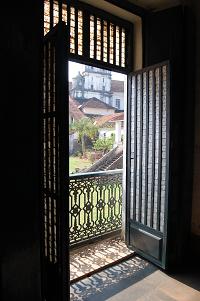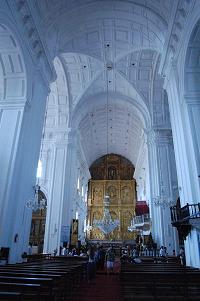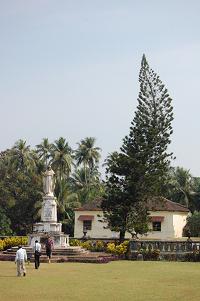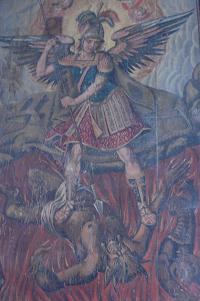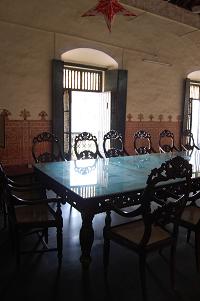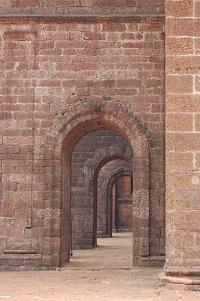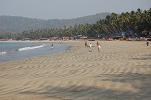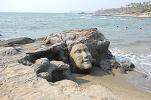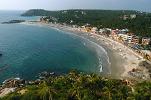Old Goa
The Historical Capital Of Golden Goa
| A UNESCO listed World Heritage site, Old Goa or Velha Goa was the capital of Portuguese Goa from the 16th Century. It was the largest and richest city in Asia with a population of 300,000, more than Lisbon or London at the time. The old name, Goa Dourada, means 'Golden Goa' and a popular phrase of the period stated, `Quem viu Goa, dispensa de ver Lisboa’ - 'One who has seen Goa need not see Lisbon.' |
Ravaged by malaria and plagues and with the gradual silting up of the Mandovi River on which it was situated, the city declined throughout the 17th Century. By the 18th Century it was largely abandoned in favour of the new capital,
Panaji. The narrow, winding streets of the suburbs were left to decay, reclaimed by the jungle, and only the sacred buildings of the center remained, becoming known as Velha Goa.
Today the remains of Old Goa are an important tourist attraction and pilgrimage site for Indian Christians. Most of the grounds and churches are free to walk around, with small admission prices charged for a few of the museums. The architecture is largely European Rennaissance and Baroque with buildings maintained to a very high standard.
Sites of Old Goa
Adil Shah's Doorway - Only remains of the palace of Adil Shah - Islamic ruler of Goa until the arrival of the Portuguese. The basalt doorway stands alone on a plinth and is reached via five steps.
Archbishop's Palace - Standing between Se Cathedral and the Church of St Francis of Assisi, the Archbishop's Palace is the only remaining civil building of colonial Goa's golden period. Houses a gallery of Christian art. The building served as an audience hall for the Archbishop.
Archeological Museum - Part of the old Franciscan monastery neighbouring the Church of St Francis of Assisi, it became a museum in 1964. Houses Portuguese and pre-colonnial artefacts as well as a portrait gallery of Portuguese governers upstairs.
Augustinian Monastery - To the west of the main square and now in ruins the monastery, founded in 1572, was once the grandest building in the colony. The bell was saved from the facade when it collapsed in 1942 and is now in use in Panaji's Church of Our Lady of the Immaculate Conception.
Basilica of Bom Jesus - Completed in 1605 the Basilica houses the remains of St Francis Xavier, Goa's patron saint. The stunning facade and impressive interior make this Goa's most architecturally brilliant church. The Basilica becomes the focus point of mass pilgrimage on St Francis Xavier's Saint's Day on the 3rd of December.
Chapel of St Anthony - On Holy Hill to the west of the main site, the restored chapel was commissioned in the 15th Century and later renovated by the Portuguese. The painted figure represents St. Anthony, patron saint of the Portuguese armed forces. In a bizarre tradition, the statue, which held the rank of army captain, was taken in a procession every year to the Treasury to collect its wages.
Chapel of St Catherine - Just to the west of the Archeological Museum, the small chapel was granted cathedral status in 1534 until the construction of the Se Cathedral. The facade of the Se was modelled on St Catherine's.
Church and Convent of St. Cajetan - Built in the 17th Century the church is a replica of St Peter's in Rome. The attatched convent is today used as a college for newly ordained priests.
Church of Our Lady of the Mount - East of the main square and on a wooded hilltop the church gives stunning sunset views of the old city.
Chapel of Our Lady of the Rosary - Situated on Holy Hill to the west of the main site, the church was completed in 1549 and is a fine example of Manueline architecture (15th & 16th Century Portuguese style celebrating Portugal's naval success by integrating nautical motifs such as anchors, ropes etc). Contains the tomb of Catarina a Piro, believed to be the first European woman to set foot in Goa.
Church of St Francis of Assisi - Completed around 1661 the church stands near the Se Cathedral in the main square. It stands on the site of an earlier Franciscan church and still includes some of its features such as the impressive Manueline doorway.
Convent and Church of St John of God - Situated on Holy Hill this abandoned church is surrounded by dense foliage and dates from the late 1600s.
Convent of St Monica - On Holy Hill the convent was rebuilt after a fire in 1636. It is occupied to this day by nuns of the Mater Dei Institute, though is rather dilapidated. Try ringing the bell to be shown around. The attatched church contains a crucifix whose Christ is said to have once opened its eyes and bled from the wounds of the crown of thorns.
Pillory - The pillory once stood in the main square of the city, but is now at a site further south, choked by weeds. The stone columns were from a Hindu temple, and the pillory was used to torture criminals.
Se Cathedral - The largest church in Asia, the Se is situated on Old Goa's main square and was completed in 1652. The celestial, white interior features six depictions from the life of St Catherine to whom the cathedral is dedicated.
Museum of Christian Art - Next to the Convent of St Monica on Holy Hill, the musueum houses artifacts of Roman Catholic art. There is a small entrance fee.
Viceroy's Archway - The old entrance to the city, via the Mandovi river. Erected in 1599 the archway is the only piece of the walls that remains standing.
|
Tours and OrientationMany package tours offer Old Goa as an optional day excursion. Alternatively a two day tour, the
Dudhsagar Special, is offered by the GTDC (Goa tourism department). The tour has an overnight stay and also covers the Dudhsagar Falls. It can be booked at the GTDC Panaji Residency in
Panaji (tel. 0832/222 3396).
Old Goa is quite easily navigated independently, and requires 1 to 2 days. From the roundabout (opposite the post office) at the south east of the main square 5 roads lead off to all the main attractions.
The Se Cathedral, Archbishop's Palace, Chapel of St Catherine, Archeological Museum and Church of St Francis of Assisi are on the north side of the main square. East of these are the Viceroy's Archway, Adil Shah's Doorway, Church and Convent of St Cajetan and further east, up the hill, the Church of Our Lady of the Mount.
On the south side of the main square sits the Basilica of Bom Jesus and beyond the square, further south, the Pillory. West of the Basilica is Holy Hill where you will find the Convent and Church of St John of God, the Convent f St Monica, Museum of Christian Art, Augustinian Monatery, Chapel of St Anthony and the Chapel of Our Lady of the Rosary.
The Mandovi river runs east to west to the north of Old Goa.
Getting There
The site is a 30 minute road journey from Panaji, Goa's capital. Taxis or rickshaws ply the route and the distance is less than 10 km, so the fare should be inexpensive.
Buses run from Panjim's Kadamba bus stand every 15 minutes, dropping off at the south-east side of Old Goa's main square, near to the Basilica of Bom Jesus.
Practicalities
There is little in the way of refreshments at the site - it is adviseable to bring water and food if you plan to stay the day. Bring a lot of water, since it is very hot during the day, especially if you are climbing te hills.
There is no accommodation in Old Goa - visitors can stay in Panaji nearby or other tourist areas from where it is easily accessible as a day trip, such as Baga beach, Calangute and Anjuna.
For a striking comparison to Old Goa visit the 14th to 16th Century ruins of Vijayanagara, or Hampi, capital of the Hindu Vijayanagara Empire in neighbouring Karnataka. Also a UNESCO World Heritage Site, Hampi makes a great 3 or 4 day trip from Goa, and is an unforgettable experience.
Discover more inland Goa attractions!
^TOP^
Click here to leave Old Goa and return to Travel India Goa Guide Home
Ancient Goa History -
Portuguese History Of Goa -
Goa Guide -
Terekhol Fort In Goa -
Goa Map




